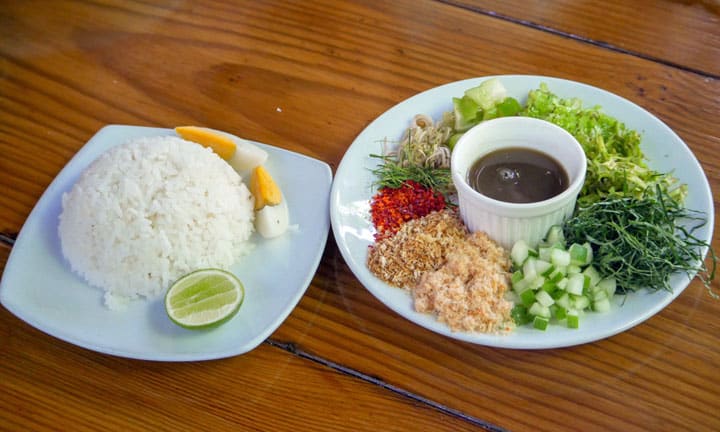Khao Yum (rice salad) with recipe
Khao Yum is a rice dish from the south of Thailand. The dish is flavored with roasted coconut, fragrant herbs and fish paste. The special thing about this dish is that it is usually served unmixed, with the herbs, vegetables and fish surrounding the rice. It is healthy and easy to digest, highly recommended if you want to consume few calories.
Khao Yum, also known as Khao Yam, is a colorful and aromatic rice salad that originated in southern Thailand. This traditional dish has a rich history and is deeply rooted in the culinary traditions of the region. Khao Yum is popular not only in Thailand but also in neighboring parts of Malaysia where it is known as Nasi Kerabu.
Origin and history
Khao Yum has its origins in the southern regions of Thailand, an area known for its unique and diverse culinary influences, drawn from both Thai and Malaysian cultures. This dish dates back to a time when natural resources and local ingredients were fully used in everyday cooking.
Over the years, Khao Yum has spread and evolved, with each region adding its own variation and twist to the recipe. However, the basis of the dish, a combination of herbs, vegetables and rice, has remained largely unchanged.
Particularities
Khao Yum is distinguished by its striking colorfulness and the use of a range of fresh ingredients. It typically consists of boiled rice served with a variety of finely chopped vegetables and herbs, such as lemongrass, kaffir lime leaves, beans, young bamboo shoots, grated coconut and sometimes edible flowers.
A special feature of Khao Yum is the addition of 'Budu', a fermented fish sauce that is characteristic of Southern Thai cuisine. This sauce gives the dish a deep umami flavor. Some varieties also use a special sauce made from ground roasted coconut, palm sugar and tamarind, which provides a sweet, sour and savory flavor profile.
Flavor profiles
Khao Yum is a true taste explosion. The combination of the fresh and spicy ingredients with the rich and complex sauces results in a harmonious whole. The rice acts as a canvas on which the flavors of the fresh vegetables, herbs and the spicy, sweet and sour sauces come together.
The taste of Khao Yum can be described as a balanced mix of salty, sweet, sour and bitter, with the Budu or special coconut sauce adding a unique depth and complexity. The texture is also important, with the crispiness of the vegetables contrasting with the softness of the rice.
Khao Yum is not only a delight for the taste buds, but also for the eyes, with its vibrant colors and attractive presentation. It is a perfect example of Southern Thailand's rich and diverse culinary culture and is a must-try for Thai cuisine enthusiasts looking for a unique and authentic dining experience.
Be sure to order the dish when you're in the South.
Khao Yum (rice salad) recipe
Khao Yum is a Thai rice dish served with a variety of toppings and sauces. It is often eaten for lunch or dinner and is a popular choice for those looking for a tasty and healthy alternative to Western fast food.
Ingredients:
- 1 cup of jasmine rice
- 1 teaspoon salt
- 1 teaspoon of turmeric
- 1 cup of coconut milk
- 1/2 cup of water
Variety of toppings of your choice, such as cooked shrimp, minced meat, tofu, cucumber, coriander, lime juice, peanuts, Thai fish sauce and chili pepper
Preparation method:
Cook the rice according to the instructions on the package. Add the salt and turmeric to the cooking water before adding the rice.
Let the rice cool down and mix it with the coconut milk and water. Stir well until the rice has an even, moist consistency.
Transfer the rice to a plate and add toppings as desired. Serve with the sauces of your choice.
Optional: You can also add a small amount of cooked, peeled beans, carrots, or other vegetables to the rice for added flavor and nutritional value. Experiment with different toppings and sauces to customize the dish to your own taste. Enjoy your Khao Yum!
Enjoy!
Disclaimer: There are many ways to prepare Thai food. The ingredients can also differ, as there are different variations. So you may come across another recipe for this dish that looks different. That is normal, because it may also have to do with local influences or the preferences of the chef.


